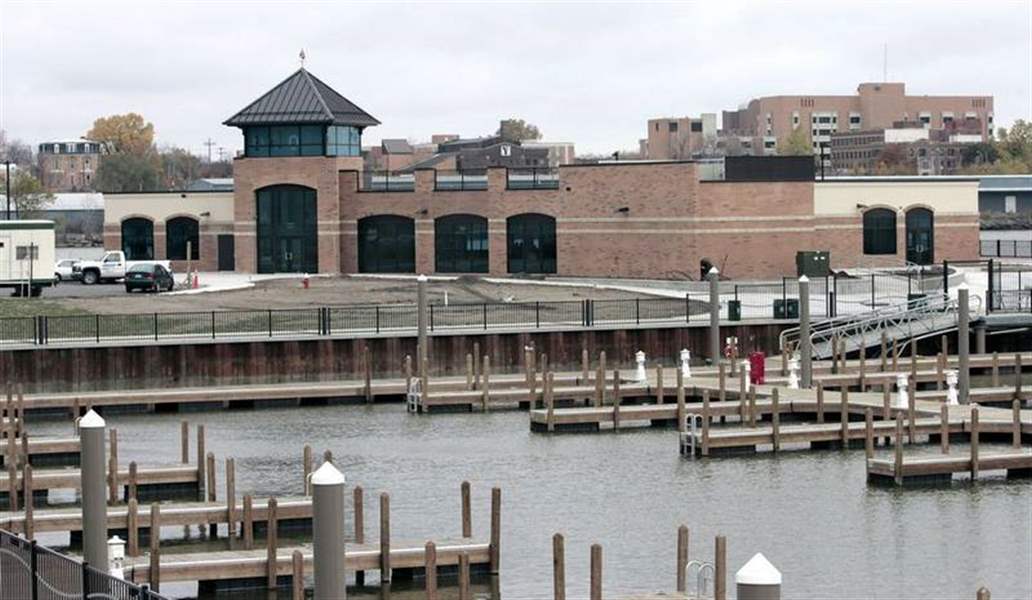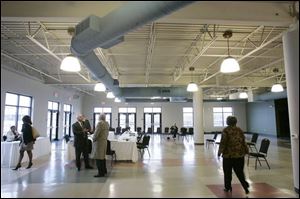
East Toledo site intrigues ferry operators
11/16/2007
The marine passenger terminal along Front Street on the east side is adjacent to Toledo s Glass City Municipal Marina.

The marine passenger terminal along Front Street on the east side is adjacent to Toledo s Glass City Municipal Marina.
Nearly 11 years after the idea first surfaced, Toledo has a marine passenger terminal on its waterfront.
The Toledo-Lucas County Port Authority is planning a public dedication ceremony for the $3.2 million building at the downriver end of the Marina District site in East Toledo on Monday, four days after holding its monthly board meeting in the newly built terminal s main concourse.
It s a terrific building a great thing for the city, said Doni Miller, the board of directors chairman. Now, the key is to get a service in here so it gets used.
Indeed, while Toledo has a place for ferries to stop, for now it lacks any ferries to stop there.
But the port authority has solicited proposals from potential ferry-service operators, and today will lead representatives of as many as a dozen firms that have expressed interest on tours of the new terminal.
Also on the mailing list for the port s tour invitation were the Great Lakes Cruising Coalition, a trade organization representing cruise ship operators, and U.S. Customs and Border Protection, which would need to establish inspection operations at the terminal before any vessels sailing from Canada or any other foreign country could call in Toledo.
Office space for Customs use has been provided in the terminal, said Kelly Rivera Nye, the port authority s communications director, but the space is unfinished.
Since 1997, when the terminal plan was announced, the estimated cost for Customs facilities has soared from $30,000 to $260,000, largely because of the 9/11 terrorist attacks, Mrs. Nye said.

Inside the marine passenger service, the space can be configured for banquets and meetings when not being used for ferry service.
The port authority is seeking grants for a $1.9 million second phase of the terminal project that would cover that cost and other enhancements, she said, including a rooftop observation deck and solar panels, furniture and equipment, and finishing of a marina shop at the terminal.
A third phase, estimated at $3 million, would provide a second dock and a ramp for Hovercraft-type vessels, which travel on a pressurized air cushion on the water s surface instead of floating and propelling themselves against the water.
If a feasible service proposal using Hovercraft arises during the current bidding process, Mrs. Nye said, ramp construction could be accelerated.
The original ferry proposal, when the Ohio Department of Transportation awarded the port authority $1.2 million in federal funding designated for related facilities, was to run Hovercraft between Toledo and Windsor.
Hovercraft are better suited for year-round operation in waters prone to icing over, such as Lake Erie, because they can travel at regular speeds skimming the surface, rather than breaking their way through the ice.
But while a Hovercraft was brought to Toledo in 2000 for demonstration runs, arrangements to develop the Windsor ferry service ultimately foundered.
The proposed terminal location migrated over the years from International Park to Brenner Marine and finally to the chosen location: next to the former Toledo Edison Acme Generating Station and a short distance up the Maumee River from I-280.
Additional grants boosted the project s federal funding to $2.6 million, which was combined with $611,000 in port authority money to build the terminal.
The city of Toledo will use part of the building as an office for the adjoining Glass City Marina.
Any firm now wishing to submit a ferry-service proposal to the port authority is required to take the terminal tour today and will have submit its plan by Dec. 7.
Proposals are to be reviewed by the port authority s new project development committee on Dec. 12.
Along with Windsor, potential destinations that have been discussed for a Toledo ferry service have included the Lake Erie Islands and Detroit.
Mrs. Nye said it is possible that multiple operators could be signed up to use the terminal if they have viable service proposals, and that 2008 could be a year of experimental service.
Six cruise-ship companies offer seasonal tours on the Great Lakes, and the port authority hopes the terminal s presence will induce one or more them to call on Toledo.
Several Great Lakes cruises visited Toledo during the late 1990s, but no such stops have occurred recently.
Port officials expect all furnishings in the terminal s main concourse to be portable, Mrs. Nye said, so that the concourse also can be used for banquets, especially during the winter if ferry operations start on a seasonal basis.
Contact David Patch at:dpatch@theblade.comor 419-724-6094.